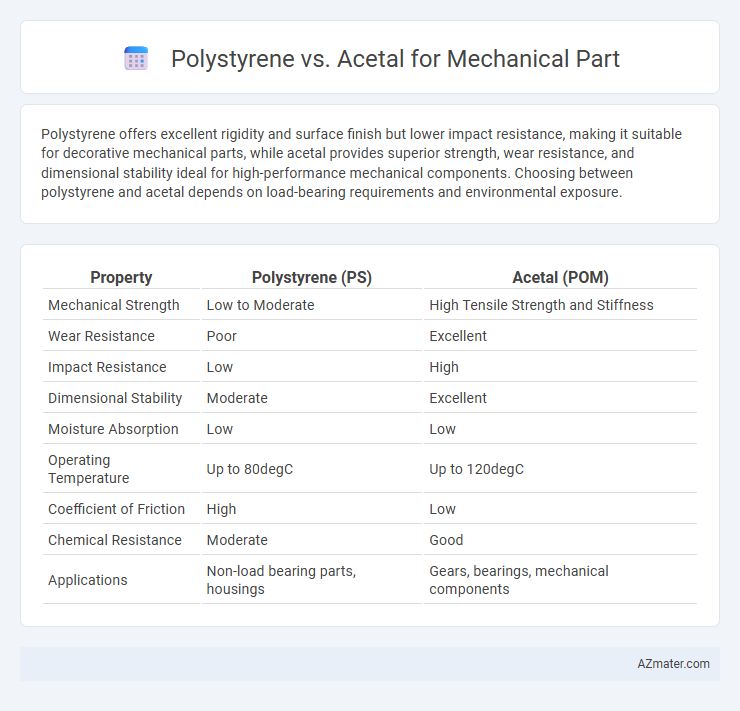Polystyrene offers excellent rigidity and surface finish but lower impact resistance, making it suitable for decorative mechanical parts, while acetal provides superior strength, wear resistance, and dimensional stability ideal for high-performance mechanical components. Choosing between polystyrene and acetal depends on load-bearing requirements and environmental exposure.
Table of Comparison
| Property | Polystyrene (PS) | Acetal (POM) |
|---|---|---|
| Mechanical Strength | Low to Moderate | High Tensile Strength and Stiffness |
| Wear Resistance | Poor | Excellent |
| Impact Resistance | Low | High |
| Dimensional Stability | Moderate | Excellent |
| Moisture Absorption | Low | Low |
| Operating Temperature | Up to 80degC | Up to 120degC |
| Coefficient of Friction | High | Low |
| Chemical Resistance | Moderate | Good |
| Applications | Non-load bearing parts, housings | Gears, bearings, mechanical components |
Introduction to Polystyrene and Acetal
Polystyrene is a lightweight, rigid thermoplastic known for its ease of molding and excellent dimensional stability, commonly used in applications requiring low cost and moderate mechanical strength. Acetal, also known as polyoxymethylene (POM), offers superior mechanical properties including high tensile strength, stiffness, and excellent wear resistance, making it ideal for precision mechanical parts subjected to repetitive motion. The choice between polystyrene and acetal depends on performance requirements, with polystyrene suited for simpler, less demanding components, while acetal excels in durability and load-bearing applications.
Material Composition and Structure
Polystyrene is an aromatic hydrocarbon polymer composed primarily of styrene monomers, featuring a rigid, glassy structure ideal for lightweight, low-impact mechanical parts. Acetal, also known as polyoxymethylene (POM), consists of repeating formaldehyde units forming a semi-crystalline polymer with high tensile strength, stiffness, and excellent dimensional stability. The inherent differences in material composition and molecular structure result in acetal offering superior wear resistance and fatigue endurance compared to the more brittle and less chemically resistant polystyrene.
Mechanical Properties Comparison
Polystyrene exhibits moderate tensile strength and stiffness but has lower impact resistance and ductility compared to acetal, which offers superior mechanical properties such as high tensile strength, excellent fatigue resistance, and low friction. Acetal's higher glass transition temperature and better dimensional stability under stress make it ideal for precision mechanical parts subjected to continuous wear and dynamic loads. Polystyrene is more brittle and prone to cracking, limiting its use in demanding mechanical applications where acetal's toughness and resilience are critical.
Strength and Durability Analysis
Polystyrene offers moderate strength with excellent rigidity but tends to be brittle under impact, limiting its durability in mechanical parts subject to stress. Acetal (Polyoxymethylene) exhibits superior tensile strength and fatigue resistance, making it highly durable for precision components needing dimensional stability and wear resistance. The choice between polystyrene and acetal significantly impacts the mechanical performance, with acetal preferred for high-strength applications requiring long-term durability.
Chemical Resistance and Environmental Stability
Polystyrene exhibits moderate chemical resistance but is vulnerable to degradation by solvents like ketones and chlorinated hydrocarbons, limiting its use in harsh chemical environments. Acetal (polyoxymethylene) offers superior chemical resistance, maintaining structural integrity against solvents, fuels, and lubricants, making it ideal for demanding mechanical parts. Environmental stability of acetal surpasses polystyrene, showing enhanced resistance to moisture, UV exposure, and temperature fluctuations, thereby ensuring greater longevity in outdoor or variable conditions.
Machinability and Ease of Fabrication
Polystyrene offers moderate machinability with easy cutting and shaping suitable for low-stress mechanical parts, but it can be brittle and prone to cracking during fabrication. Acetal excels in machinability, providing smooth finishes, high dimensional stability, and superior resistance to wear, making it ideal for precision mechanical components requiring tight tolerances. Its ease of fabrication is enhanced by excellent machinability and resistance to chipping, resulting in durable and reliable parts for demanding engineering applications.
Cost and Economic Considerations
Polystyrene offers a lower initial material cost compared to acetal, making it suitable for budget-sensitive mechanical parts requiring moderate strength and rigidity. Acetal, while more expensive upfront, provides superior durability and wear resistance, potentially reducing long-term maintenance and replacement expenses. Evaluating the total cost of ownership, including lifespan and performance demands, is crucial when choosing between polystyrene and acetal for mechanical components.
Applications in Mechanical Parts
Polystyrene, known for its rigidity and ease of molding, is commonly used in low-stress mechanical components such as housings, disposable parts, and prototypes where dimensional stability is less critical. Acetal (polyoxymethylene) excels in precision mechanical parts requiring high stiffness, low friction, and excellent wear resistance, making it ideal for gears, bearings, and fasteners in automotive and industrial machinery. The choice between polystyrene and acetal hinges on mechanical load requirements and durability, with acetal favored for high-performance applications demanding long-term reliability and chemical resistance.
Limitations and Potential Drawbacks
Polystyrene exhibits brittleness and low impact resistance, making it unsuitable for high-stress mechanical parts prone to shock or load variations. Acetal's potential drawbacks include susceptibility to environmental stress cracking and chemical degradation when exposed to strong acids or bases. Both materials face limitations in temperature resistance, with polystyrene degrading under heat and acetal performing suboptimally above 120degC.
Final Recommendations and Material Selection
Polystyrene offers excellent dimensional stability and cost-effectiveness for mechanical parts with low stress and impact requirements, while acetal (POM) provides superior strength, wear resistance, and low friction, ideal for high-performance applications. Select acetal for mechanical components subjected to dynamic loads or requiring precise machining and chemical resistance. Polystyrene is suitable for lightweight, non-load-bearing parts where ease of fabrication and economy are primary considerations.

Infographic: Polystyrene vs Acetal for Mechanical Part
 azmater.com
azmater.com